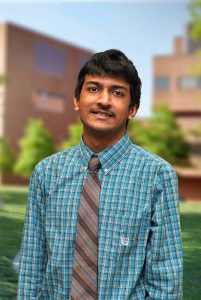Major: Physics

Abstract: Searching for Gamma-Ray Emission from Black Hole Jets
Describe your project:
My research currently entails assessing the level of gamma-ray emission coming from the relativistic jets of ionized plasma ejected from Active Galactic Nuclei (AGN), which host a supermassive black hole at their centers. This involves using the Fermi Gamma-Ray Space Telescope operated by NASA to generate what are called ‘Light Curves’, which measure the brightness over time of the jet. The big question is why these jets produce X-ray wavelength light, and confirming whether or not they produce Gamma-ray light as well allows us to determine between two different theories about the X-ray light origin.
Who is your mentor(s) for your project?
My mentors for this project are Assistant Professor Dr. Eileen T. Meyer of the Physics Department at UMBC and her graduate student Peter Breiding, who will soon be beginning his Postdoctoral Fellow position at West Virginia University. I had applied for a research assistant position that Dr. Meyer had open in her group during my sophomore year, and I was humbled to have been chosen by her to begin this project, and have subsequently become a better scientist and person because of this opportunity. Ever since I had a conversation with her and Peter when I was first starting out, I had immediately developed an interest in learning more about Gamma-Ray Astronomy since I knew so little at the time. They have both constantly pushed me to be the most successful researcher that I can be by encouraging me to ask valuable questions and having fun while I perform this research, as well as offering an invaluable amount of advice at every stage of the data analysis process and encouraging me to present my findings!
How did you become interested in this project?
I have been interested in Astronomy and Astrophysics from a young age and have always pondered about what types of marvelous phenomena occur beyond Earth and our solar system, so being involved in this project was natural for me. I already had considerable coding experience before starting this project, which has proven to be a major strength of mine since virtually all of my work involves using some variant of a high level programming language (Python, Perl, R, etc.).
What has been the hardest part about your research/what was the most unexpected thing about being a researcher?
The most challenging part about my project so far has been understanding the overwhelming amount of theory associated with Radio-Loud AGN and Black Hole Jets, since all of these concepts are typically contained within graduate level textbooks, which is far beyond what I would be expected to know at the undergraduate level. Because of this deficiency of mine, I have since devoted considerable time to reading countless Astrophysical publications and graduate texts ahead of time to progress my knowledge of these subjects, which has been an eye-opening and fun experience!
What has been the most rewarding part?
I would say that the most rewarding portion of my project so far has been the level at which people have been appreciative of what I have been able to accomplish so far and will accomplish in the future. The amount of data that I have been able to analyze so far has been massive, and the Light Curve Analysis in particular can be very computationally intensive. As a result, it can be intimidating to choose which specific results to include in a publication or presentation, so being encouraged to share my findings with the rest of the scientific community has been a very reassuring feeling.
How will you disseminate your research?
I will be presenting my research at the American Astronomical Society Meeting in January of 2019 in Seattle, Washington, as well as at URCAD in April. I will also be a coauthor of a publication that our research group plans to publish over the upcoming year in the Astrophysical Journal, which implements my recent findings.
What is your advice to other students about getting involved in research?
Have a clear goal of what topic you would like to explore and what you want to achieve in the long term, and have the ability to adapt to uncomfortable situations. Scientific research is all about presenting your findings in a concise and orderly matter, while at the same time being able to accept and respond to impromptu criticism. Therefore, it is imperative that you are able to devote time to becoming as much of an expert in your particular field as possible, while at the same time developing a broader knowledge of more abstract topics should the time come that you are questioned by experts.
What are your career goals?
After obtaining my Bachelor’s Degree in Physics, I plan on pursuing graduate studies up to a Ph.D. in Astrophysics. I intend to continue conducting research on events associated with High Energy Astrophysics, while potentially expanding my knowledge more broadly to fields like General Relativity and Astroparticle Physics. Some topics which I am considering studying at a high level include exotic phenomena such as AGN, Tidal Disruption Events, Neutron Stars, Pulsars, and Gamma-Ray Bursts (just to name a few!).
10/2/18